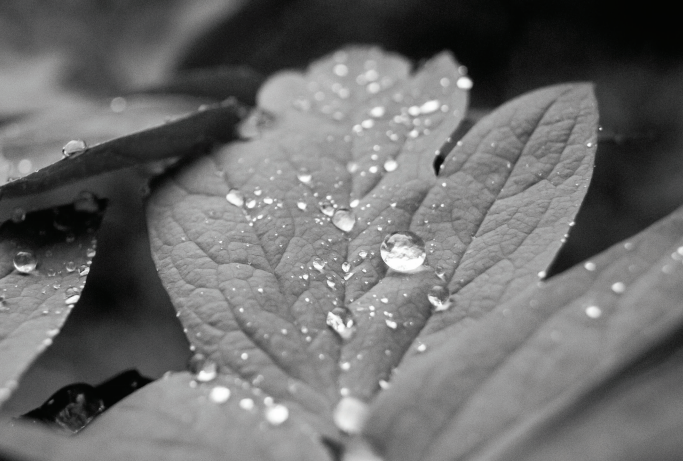
“Aqueous Sphere” by Ben Cunning
Ben Cunning is a photographer and chemistry professor. Here, he talks about his love for making the concrete abstract and the relationship between chemistry and photography.
Tell me about the photograph that will appear in this issue of Welter, Aqueous Sphere.
I can’t remember the exact date, but I took that one in late winter/early spring at Longwood Gardens. I really liked the way that that particular raindrop had settled on the leaf and how it was almost perfectly spherical. Everything around it was all different shades of green, so my mind immediately jumped to, [making it] black and white, because it was all fairly nicely contrasted and all kinds of monotone, monochrome colors.
What style of photography do you favor?
I try to stay towards macro because that’s the genre I love the most. I like to try and come across common things and present them in an uncommon way. But you know, macro photography, fine art photography, it doesn’t pay the bills. So I’ve done portraits, family portraits, graduation photos, that kind of stuff, and I do photography for businesses, products and the like. I do a little bit of everything.
I’m not familiar with macro. What is it?
Macro photography is a very specific genre where we try to have objects at life-scale in the frame. We’re capturing 35 millimeter-wide snippets of objects. It’s kind of like getting really, really, really, really close with your eye, with a magnifying glass. It’s just the most incredible detail because when you print [a macro photo], you’re printing it much larger than the 35 millimeter frame.
Personally, I like to do my macro a little bit more abstract. As an undergraduate, I was really inspired by O’Keeffe. I thought it was very interesting how she was able to take flowers and represent them as something very different than flowers. I tried to do that too. I like to take something and represent it in a way that makes it a little more abstract.
I understand you’re a chemistry professor, as well. Do you see a relationship between chemistry and photography?
Absolutely. I mean, the chemistry of film is, of course, the low hanging fruit here, and developing in the old-fashioned ways in the darkroom–which is how I actually learned, because I started this when I was 14. My high school had a very small dark room, and I still remember to this day that we would bulk load our own film from Kodak, and then we were responsible for developing our own film. That’s probably where I fell in love with the process, and the chemistry of that kind of feeds into all kinds of chemistry. But at its core, chemistry is the study of matter, and photography inherently requires matter.
